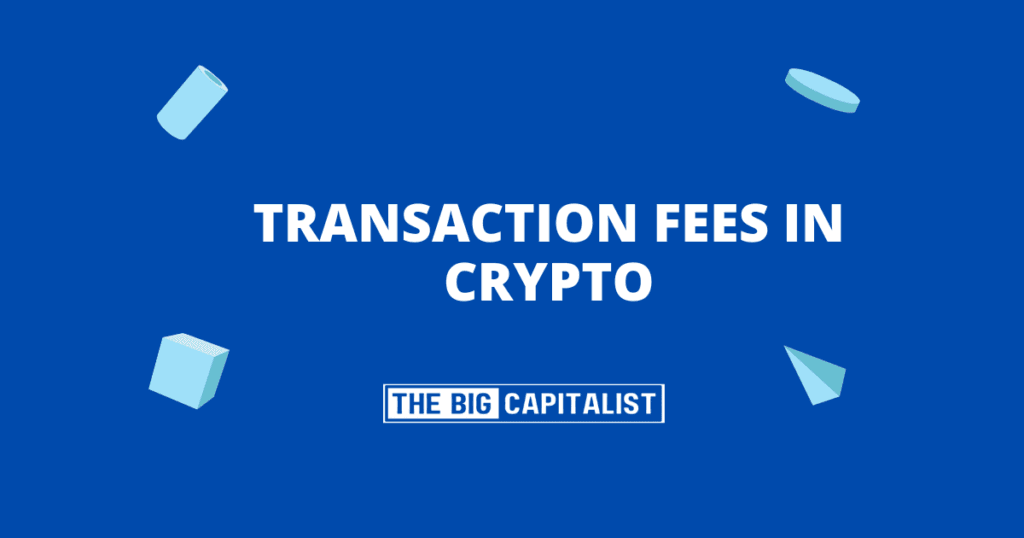Navigating the world of cryptocurrencies can be complex. One aspect that often confuses newcomers is transaction fees in crypto.
These fees are a crucial part of the blockchain ecosystem. They ensure transactions are processed and maintain the security of the network.
But what determines these fees? And why do they vary across different cryptocurrencies?
This article will delve into these questions. We’ll explore what transaction fees are, why they’re necessary, and how they’re calculated.
We’ll also discuss gas fees in crypto, a concept unique to Ethereum and other smart contract platforms.
By the end of this article, you will understand transaction fees in crypto better. You will also learn how to manage them effectively.
Understanding Transaction Fees in Cryptocurrency
Transaction fees in cryptocurrency are payments made to miners or validators. These fees compensate network participants for verifying and adding transactions to the blockchain. They play a fundamental role in keeping the network secure and efficient.
These fees help to prevent spam transactions. By imposing a cost, the system discourages malicious users from overloading the network. This ensures smooth operation and prioritizes genuine transactions.
Transaction fees can differ across various cryptocurrencies. Some networks use dynamic fee models, which adjust based on demand and network congestion. Others may employ a fixed fee structure.
Key Functions of Transaction Fees:
- Compensate miners and validators.
- Prevent spam by imposing costs.
- Prioritize legitimate transactions.
- Contribute to network security.
Understanding transaction fees involves knowing their calculation. It typically depends on the transaction size and network conditions. This calculation influences how quickly a transaction gets processed.
In some cases, users can choose to pay a higher fee. This increases the priority of their transaction, ensuring faster processing times. Conversely, lower fees might result in longer wait times during peak periods.

Why Are Transaction Fees Necessary?
Transaction fees are essential for several reasons. They provide incentives for miners and validators, ensuring the security and functionality of the network. Without these fees, network participants might lack motivation to verify transactions.
These fees also serve to deter network abuse. Without them, the risk of spam transactions and network congestion would increase. Transaction fees maintain order and functionality within the blockchain.
Moreover, transaction fees support network sustainability. As block rewards diminish over time, fees ensure continuous compensation for those maintaining the blockchain.
How Are Transaction Fees Calculated?
Transaction fees depend on several factors. The size of a transaction in bytes often determines the fee in networks like Bitcoin. Larger transactions typically require higher fees.
Network conditions play a role too. During times of high demand, fees may increase to manage congestion. Users can adjust the fees they wish to pay based on how urgently they need the transaction processed.
In some networks, users specify a fee to ensure their transaction is picked promptly. This flexibility allows users to balance cost with processing speed, optimizing their transaction experience.
What Are Gas Fees in Crypto?
Gas fees are specific to blockchain platforms that support smart contracts, like Ethereum. These fees are paid for executing operations and transactions on these platforms. Essentially, gas fees act as the fuel that powers decentralized applications.
In the context of Ethereum, gas fees are essential for executing smart contracts and transactions. Every operation on Ethereum, be it a simple transaction or a complex contract execution, requires gas. This ensures that resources are allocated efficiently across the network.
Gas fees also prevent the network from becoming overloaded. By requiring users to pay for computational work, the network prioritizes legitimate requests. This mechanism ensures that network resources are not misused by spam or malicious activities.
The concept of gas fees can seem complex initially. However, they play a crucial role in maintaining the health and performance of blockchain networks. They enable a self-regulating system that balances demand with available resources effectively.
The Mechanics of Gas Fees
Gas fees are calculated based on two main components: gas limit and gas price. The gas limit specifies the maximum amount of work a transaction can consume. Users set this limit based on the complexity of their transaction.
The gas price is the amount users agree to pay per unit of gas. It is measured in gwei, which is a small fraction of Ethereum. A higher gas price can ensure a transaction is processed faster during periods of high activity.
When sending a transaction, users multiply the gas limit by the gas price to determine the total fee. This allows for flexibility in choosing how much to pay based on urgency and current network congestion.
Factors Affecting Gas Fees
Gas fees fluctuate due to several factors, primarily network congestion. High demand leads to increased fees as users compete to have their transactions processed quickly. This often occurs during popular token launches or market volatility.
Complexity of the transaction also impacts gas fees. More complex transactions, involving multiple operations, require more gas. Thus, they incur higher fees compared to simple transfers.
Additionally, user behavior can affect gas fees. For instance, users in a hurry may offer higher gas prices to speed up their transactions. This competitive bidding can drive fees higher, especially during peak times.
Blockchain Fees Across Different Cryptocurrencies
Blockchain fees vary significantly across different cryptocurrencies. These fees depend on network architecture, consensus algorithms, and user demand. Each blockchain has its own fee structure and dynamics.
For example, Bitcoin charges fees based on the size of the transaction in bytes. Ethereum fees, on the other hand, are influenced by gas requirements for computational tasks. These differences highlight how fees are tailored to the specifics of each blockchain’s functions.
Here are some notable fee structures:
- Bitcoin: Fees based on transaction size.
- Ethereum: Fees based on gas usage.
- Litecoin: Fees similar to Bitcoin with lower amounts.
Understanding these differences is key for crypto users. It affects how they plan and execute transactions on various platforms. Being aware of fee structures allows users to optimize costs across different blockchains effectively.
Comparing Fees: Bitcoin vs. Ethereum vs. Others
Bitcoin and Ethereum illustrate contrasting fee models. Bitcoin’s transaction fees hinge on data size, which can lead to high costs during network congestion. Miners prioritize transactions with higher fees, which can push costs up in busy times.
Ethereum’s fees revolve around gas, required for processing operations, making them more dynamic. Fees can escalate during periods of high activity, as users set higher gas prices for faster transaction confirmations. This is especially true when smart contracts are involved.
Other cryptocurrencies, like Binance Smart Chain or Solana, offer alternatives with generally lower fees. These platforms are designed to handle high volumes of transactions efficiently. Lower fees make them attractive options for users seeking cost-effective solutions. Understanding these fee comparisons is important for effective cryptocurrency management.
Minimizing Transaction Fees: Tips and Strategies
Reducing transaction fees is a priority for many crypto users. With the right strategies, you can save money while transacting. Planning is crucial in managing these costs effectively.
Here are some practical tips:
- Use off-peak times: Transactions are cheaper during lower network activity.
- Batch transactions: Combine multiple transactions into one.
- Use fee estimation tools: Predict and adjust fees with these tools.
- Leverage layer 2 solutions: These can lower fees by using off-chain transactions.
By adopting these strategies, users can navigate fee challenges more effectively. Optimizing transaction times and leveraging technology can significantly reduce costs. This approach ensures more efficient use of your resources in the crypto space.
Timing Your Transactions
Timing is crucial when it comes to minimizing fees. Conducting transactions during network lulls often results in reduced costs. Weekends or late nights can offer the best opportunity for lower fees.
Observing transaction patterns can help identify these low-cost windows. Users can strategically time their activities for optimal savings. This method, combined with careful planning, maximizes cost efficiency.
Fee Estimators and Tools
Fee estimation tools are valuable resources. They help users predict the cost of a transaction by analyzing current network conditions. Tools like these guide users in setting appropriate fees.
Using these tools can prevent overpaying on transactions. They assist in determining a reasonable fee for timely confirmations. By incorporating these tools, users can transact confidently without unexpected high costs.
The Future of Transaction Fees in Crypto
The world of crypto is rapidly evolving, and transaction fees are a significant focus. With technological advancements, we may see substantial changes. The future holds promise for more efficient and cost-effective solutions.
As networks upgrade and new technologies emerge, fees could become more manageable. This evolution aims to enhance the user experience while maintaining network security. With these developments, users could see reduced transaction times and costs.
Blockchain communities are constantly exploring ways to optimize fees. Innovations in this area are expected to grow as cryptocurrency adoption expands. This continuous drive will shape how fees function in the evolving crypto landscape.
Innovations and Network Upgrades
Innovations play a crucial role in shaping transaction fees. Upgrades like Ethereum 2.0 aim to improve scalability and reduce costs. These upgrades strive to balance efficiency with network security.
Future innovations could lead to further reductions in transaction fees. Such advancements not only enhance speed but also make transacting more accessible. They are vital in ensuring the continued growth of blockchain technology.
The Role of Layer 2 Solutions
Layer 2 solutions are pivotal in reducing transaction fees. These solutions operate on top of existing blockchains to handle transactions more efficiently. By shifting transactions off-chain, they alleviate network congestion.
Solutions like the Lightning Network exemplify this approach. They enable faster and cheaper transactions while retaining the security of the main blockchain. Layer 2 solutions are crucial in mitigating fee challenges as crypto adoption rises.
Conclusion
Transaction fees in crypto play a vital role in maintaining network health and security. Understanding these fees is crucial for anyone engaging with cryptocurrencies. By grasping how fees function and evolve, users can make informed decisions.
As the crypto world advances, staying informed about transaction fees is essential. With ongoing innovations, the future of transaction fees looks promising for users. Embracing these changes will help in navigating the evolving landscape of digital currencies.
Frequently Asked Questions (FAQ)
1. What are transaction fees in crypto and why do they matter?
Transaction fees in crypto are small payments made to miners or validators for processing transactions on the blockchain. These fees ensure the network remains secure, prevent spam, and help prioritize legitimate transactions. They’re essential for maintaining blockchain efficiency and sustainability, especially as block rewards decrease over time.
2. What are gas fees in crypto and how do they work?
Gas fees are a type of transaction fee unique to smart contract platforms like Ethereum. They represent the cost of computational power required to execute transactions or run decentralized applications. Gas fees are calculated based on the gas limit and gas price, and they fluctuate depending on network demand, transaction complexity, and user-set fees.
















